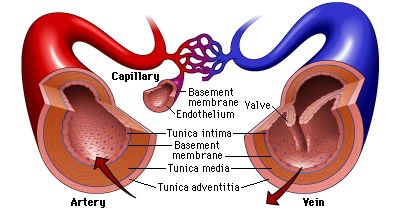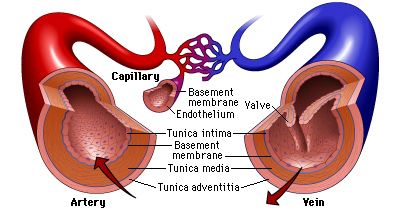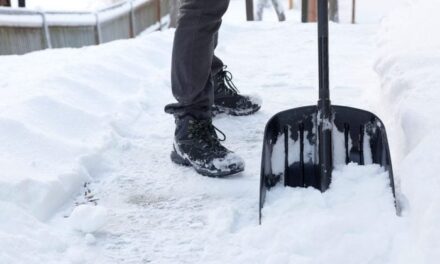Blood vessels are channels that carry blood throughout your body. They form a closed loop, like a circuit, that begins and ends at your heart. Together, the heart vessels and blood vessels form your circulatory system. Your body contains about 60,000 miles of blood vessels. Read this full article and get complete knowledge about blood vessels with Pritish Kumar.
There are three types of blood vessels:
- Arteries carry blood away from your heart.
- Veins carry blood back toward your heart.
- Capillaries, the smallest blood vessels, connect arteries and veins.

Types of blood vessels
How does blood flow through your body?
Here’s how blood flows through your body:
- Veins bring blood to the right side of your heart.
- Pulmonary arteries carry the blood to your lungs, where it receives oxygen.
- Pulmonary veins move the blood oxygen-rich blood to the left side of your heart.
- The aorta (the main artery in your body) carries the blood from the left side of your heart to the rest of your body through many branches of arteries.
- Capillaries have thin walls that allow oxygen, nutrients, carbon dioxide and waste products to pass through, to and from the tissue cells.
- Veins then carry the blood back to your heart, and the process begins again.
FUNCTION
What is the purpose of blood vessels?
The function of blood vessels is to deliver blood to the organs and tissues in your body. The blood supplies them with the oxygen and nutrients they need to function. Blood vessels also carry waste products and carbon dioxide away from your organs and tissues.
Each type of blood vessel serves a different function:
Arteries: These strong, muscular blood vessels carry oxygen-rich blood from your heart to your body. They handle a large amount of force and pressure from your blood flow but don’t carry a large volume of blood. At any given time, only about 10% to 15% of your body’s blood is in your arteries.
Arterioles: Arteries branch into smaller vessels called arterioles. Both arteries and arterioles are very flexible. They get bigger or smaller to help maintain your body’s blood pressure.
Capillaries: These tiny blood vessels have thin walls. Oxygen and nutrients from the blood can move through the walls and get into organs and tissues. The capillaries also take waste products away from your tissues. Capillaries are where oxygen and nutrients are exchanged for carbon dioxide and waste.
Venules: Veins begin as tiny vessels called venules and get gradually larger as they near your heart. Venules receive blood from capillaries.
Veins: Unlike arteries, veins don’t have to carry highly pressurized blood, but they do have to carry large volumes of deoxygenated blood back to your heart. Thin, less elastic walls help them handle high volumes and low pressure. Most veins have valves that open and close. The valves control blood flow and keep your blood flowing in one direction. About 75% of your blood is in your veins.
ANATOMY
Where are your blood vessels located?
There are blood vessels throughout your body. The main artery is your aorta, which connects to the left side of your heart. It runs down through your chest, diaphragm and abdomen, branching off in many areas. Near your pelvis, your aorta branches into two arteries that supply blood to your lower body and legs.
The main vein in your body is the vena cava. The superior vena cava is in the upper right part of your chest. It carries blood from your head, neck, arms and chest back to your heart. The inferior vena cava is near the right side of your diaphragm. It brings blood from your legs, feet, abdomen and pelvis back to your heart.
What do blood vessels look like?
Blood vessels have a tube-like shape, but they rarely run in a straight line. Some are big enough to see under your skin. If you’ve ever had your blood drawn, you may have noticed veins on the inside of your arm. They might appear blue under your skin, even though your blood is red.
How big are blood vessels?
Some, like the aorta, have a wide diameter. For example, a normal aorta in the abdomen is about 2 centimeters wide (about the size of a nickel). But other blood vessels, such as capillaries, are extremely small. They range from 2 to 12 micrometers, which is even less than the diameter of a human hair.
What are the blood vessels made of?
Blood vessels have three layers of tissue:
Tunica intima: The inner layer surrounds the blood as it flows through your body. It regulates blood pressure, prevents blood clots and keeps toxins out of your blood. It keeps your blood flowing smoothly.
Media: The middle layer contains elastic fibers that keep your blood flowing in one direction. The media also helps vessels expand and contract.
Adventitia: The outer layer contains nerves and tiny vessels. It delivers oxygen and nutrients from your blood to your cells and helps remove waste. It also gives blood vessels their structure and support.
How can I keep my blood vessels healthy?
There are a variety of ways you can improve the health of your blood vessels, including:
- Eat a healthy, balanced diet that is low in sodium, cholesterol and saturated fats.
- Exercise regularly.
- Manage your blood pressure.
- Quit smoking.
- Reduce alcohol consumption.
Reference
https://my.clevelandclinic.org/health/body/21640-blood-vessels









